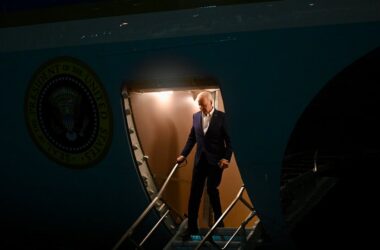The United Automobile Workers union has increased pressure on Ford Motor and General Motors by extending its strike to two additional car assembly plants. The union claims that the companies have not done enough to meet its demands for higher pay and benefits.
This move marks the second escalation of strikes since September 15, when the strikes began at three plants, one owned by each of the three companies: G.M., Ford, and Stellantis (parent company of Chrysler, Jeep, and Ram). However, the union has decided not to expand the strike against Stellantis, as negotiations with that company have shown progress.
The U.A.W.’s president, Shawn Fain, announced that workers at a Ford plant in Chicago and a G.M. factory in Lansing, Mich., would be walking off the job on Friday. The Lansing plant produces Buick Enclave and Chevrolet Traverse sport-utility vehicles, while the Chicago plant manufactures the Explorer, Police Interceptor Utility, and Lincoln Aviator.
In a live-streamed video, Mr. Fain stated, “Ford and G.M. have refused to make meaningful progress at the bargaining table.”
The Ford Chicago plant employs approximately 4,600 U.A.W. members, while the G.M. Lansing plant has 2,300 union workers. These additional strikes, combined with the earlier walkouts, have now called on more than 25,000 U.A.W. members to stop working. The three automakers collectively employ nearly 150,000 U.A.W. members.
Last week, workers went on strike at 38 spare-parts distribution centers owned by G.M. and Stellantis. The U.A.W. did not expand the strike at Ford because significant progress had been made in negotiations with that company.
The U.A.W. is advocating for a substantial wage increase for workers, initially demanding a 40 percent raise. The union points to the significant profits the three companies have generated over the last decade, as well as the size of the pay increases for their top executives in recent years.
The companies have proposed salary increases of about 20 percent over four years. Ford and the union have reached agreements on some other demands, including cost-of-living adjustments in the event of inflation surges and the right to strike if a plant is closed.
Erik Gordon, a business professor at the University of Michigan who follows the auto industry, commented on the negotiations, stating, “Fain is out-negotiating the car companies, and he is having fun making them dance while he calls them names. One week he gets Ford to give more in the hope of not being targeted for another closure. The next week he tells Ford they haven’t given enough and closes one of their plants.”
However, Professor Gordon also warns that if the companies comply with most of the union’s demands, they may struggle to compete in the growing electric vehicle market, where nonunion automaker Tesla dominates. He explains, “The union will enjoy big gains for a few years until the companies’ inability to compete causes job losses.”
Negotiations have been ongoing, with the union presenting its latest counteroffer to Stellantis on Thursday. A meeting between the U.A.W. and G.M. negotiating teams took place on Wednesday, attended by Mr. Fain.
There was a delay in Mr. Fain’s online remarks on Friday due to a surge of interest from the companies in addressing significant bargaining issues. However, no further details were provided.
Ford’s CEO, Jim Farley, stated on Friday that the company and the U.A.W. were “very close” to reaching a deal. However, differences in potential contract terms for workers at the four electric vehicle battery factories Ford is constructing remain unresolved. Farley added, “If the U.A.W.’s goal is a record contract, they already have that.”
Ford believes that discussions about the battery plants should not impede negotiations on a new four-year contract, as the plants will not be operational for another two years or more.
The U.A.W. disagrees and wants workers at battery factories owned fully or partially by automakers to be included in the national contracts with the U.A.W. The union argues that workers in battery factories face more hazardous working conditions and receive significantly lower pay compared to U.A.W. members at vehicle assembly plants.
The automakers argue that they cannot include battery factory workers in their national contracts because most of these plants are joint ventures with foreign companies such as LG Energy Solution and SK On.
Among the three automakers, only G.M. has begun producing batteries, in collaboration with LG Energy Solution at a plant in Lordstown, Ohio. Ford is building three battery plants in Kentucky and Tennessee with SK On.
This week, Ford announced the suspension of work on another battery plant in Marshall, Mich., which it had planned to build. The company cited uncertainties regarding its ability to compete on price and stated that it will determine the size of the plant once it has a better understanding of the costs associated with battery production.
Mr. Farley clarified that the start of production at battery plants would not result in U.A.W. job losses elsewhere in Ford. The company employs more U.A.W. members than G.M. and Stellantis, with a total of 57,000.
In response to Ford’s characterization of the negotiations, Mr. Fain disputed the company’s claims and stated that the U.A.W. was awaiting a response to a comprehensive proposal made on Monday. He emphasized that the two sides remain “far apart” on retirement benefits and workers’ job security during the transition to electric vehicles, inviting Ford to name the time and place to settle a fair contract.
G.M.’s CEO, Mary T. Barra, criticized the union for escalating rhetoric and staging theatrics, accusing the U.A.W. leaders of having no real intention of reaching an agreement. She stated, “We need the U.A.W. leadership at the bargaining table with the clear intent of reaching an agreement now. For them to do otherwise is putting our collective future at stake.”
Stellantis reported progress in the talks but acknowledged the existence of remaining gaps. The company expressed its commitment to finding solutions to the issues concerning employees’ concerns while maintaining competitiveness.
Tensions on the picket lines have escalated this week, with the union reporting minor injuries to five picketers who were hit by a car outside a G.M. plant in Flint, Mich. Confrontations have also occurred at picket lines in California, Massachusetts, and Michigan.
Mr. Fain reaffirmed the union’s determination, stating, “We will not be intimidated into backing down.” He frequently characterizes the strike as a “war on corporate greed.”
Stellantis responded to Mr. Fain’s rhetoric, criticizing his inflammatory language and blaming the union for instances of violence, such as slashing tires on trucks and harassing non-striking employees at parts warehouses.
Stellantis declared, “The deliberate use of inflammatory and violent rhetoric is dangerous and needs to stop. The companies are not ‘the enemy,’ and we are not at ‘war.’ We respect our employees’ right to advocate for their position, including their right to peacefully picket. But the violence must stop.”
The union’s strategy of striking at a limited number of locations but spreading the walkouts to plants owned by all three automakers deviates from the U.A.W.’s traditional approach of halting operations at one company entirely. In 2019, union workers struck at G.M. for 40 days before reaching a tentative agreement.
According to Mr. Fain, this strategy aims to keep the companies uncertain about which parts of their operations will be affected in order to strengthen the union’s negotiating position. The initial strikes impacted plants producing some of the most profitable vehicles for the automakers.
A limited strike also affects the companies’ profits while minimizing damage to their suppliers, local businesses, and the national economy. However, expanding the strike places an increased financial burden on the union, which is paying striking workers $500 a week from its $825 million strike fund.
Santul Nerkar contributed reporting.








